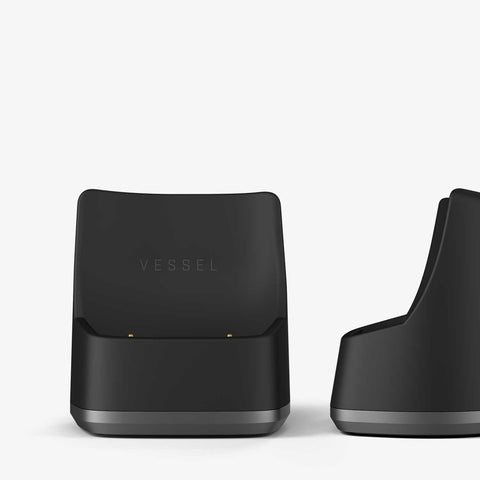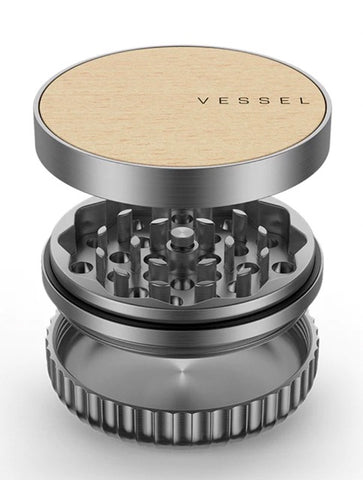
As you may have guessed from the name, a dry herb vaporizer is a nifty gadget that heats up your dried cannabis to produce vapor. But why go through all that trouble, you ask? Well, it turns out there are a lot of benefits to vaping your weed instead of smoking it.
Whether you're on the fence about switching to a dry herb vaporizer, or you're just curious to learn what all the fuss is about, you're in the right spot. In this article, we’re going to break down everything you need to know about dry herb vaporizers, from the different types to the ins and outs of using them. Let's start!
What is a dry herb vaporizer for weed?
A dry herb vaporizer is an electric device intended to vaporize the herb without combusting it. The dry herb of choice is placed in a special chamber in the device. The electric power from a battery is used to heat the chamber in a highly controlled fashion, vaporizing the herb without catching it on fire. The user then inhales the vapors.
Types of dry herb vaporizers
Dry herb vaporizers come in all shapes and sizes, but the real difference lies in how they heat your herb and where you can use them. Let's break it down into the main types you'll encounter.
Portable Vaporizers
Portable vaporizers are great for solo sessions or convenience on the go. They're small enough to slip into your pocket but pack a punch with their efficient use of either convection or conduction heating methods. Convection types gently heat the herb with hot air, while conduction types use direct contact with heated coils.
Desktop Vaporizers
If you want something more potent, desktop vaporizers should be your pick. These units are larger and need to be plugged in, so they’re usually used at home. Since it has a higher herb capacity, it also comes with a bigger price tag. Like the portable ones, desktop vaporizers can also either use convection and conduction heating.
Multi-Use Vaporizers
For those who love variety, multi-use vaporizers are the choice pick. These vaporizers can handle not just dry herbs but also waxy concentrates and oils. Most vaporizers can only use powdered, loose herbs, but multi-use ones give you flexibility, allowing you to switch between different types of cannabis products with ease.
Pros of dry herb vaporizers
Dry herb vaporizers have many advantages over joints, pipes, and bongs:
- They are small and discrete and can be transported and used anywhere
- They do not emit strong odors into the local environment
- They do not expose the user to harsh, irritating, potentially toxic smoke
- They use less material than in a joint to get the same effect
- They have an instantaneous effect, allowing the user to control the dose precisely
- They have a better flavor
- They have no need for a lighter or matches
- They create no risk of accidentally starting a fire
Dry herb vaporizers may also be healthier than smoking a joint or pipe. All of the actual research on the health impact of smoking versus vaping has been conducted on tobacco, and thus it may not apply to other herbal products. However, most of the harm of smoking is caused by combustion products and the smoke itself, which are not produced by dry herb vaporizers.
Cons of dry herb vaporizers
Dry herb vaporizers do have a few cons:
- They cost more to purchase than pipes or rolling papers
- The battery needs to be charged, or they don't work
- Finding a high-quality vaporizer may take some work
- There is a learning curve about how to control the dose
How to use a dry herb vaporizer?
Dry herb vaporizers are straightforward to use. Just follow these simple steps:
- Charge it: For an uninterrupted session, make sure you fully charge your vaporizer before anything else.
- Grind your herb: Grind your dry herb into a fine powder so it vaporizes well. A coffee or kitchen herb grinder works perfectly.
- Store it properly: After grinding, store your herb in an airtight container. Don’t use clear, plastic ones and opt for glass or metal containers.
Buy this storage canister from Vessel
- Load it up: Depending on your vaporizer’s design, carefully load your precious herb in. If you’re unsure, follow the manual.
- Heat it up: Start heating up your herb using your preferred temperature settings.
- Maintain regularly: To prolong your vaporizer’s lifespan and get consistent, optimal performance, clean it regularly. Residue from your sessions can build up, which can clog up your device and leave a bad taste.
What is a portable vaporizer?
A portable vaporizer is a convenient and discreet way to enjoy cannabis on the go. Thinking of getting one for yourself? Consider the following factors:
Budget
Your starting point should be your budget. Prices can vary widely depending on design, material, and aesthetics. Think about your must-have features and how often you will be using your vaporizer. Higher-priced models usually offer better vapor quality, more temperature controls, and durability. However, there are also budget-friendly options that do a decent job. Do research and shop around to find the best fit for your use.
Type of Cannabis Used
Think about the type of cannabis you prefer. Some vaporizers are designed specifically for dry herb, while others are compatible with waxes and oils. Multi-use vaporizers offer flexibility but may come with a higher price tag.
Discretion (Portable or Not?)
This depends on where and how you plan to use your vaporizer. Fortunately, portable vaporizers are built for discreteness. Look for compact, low-profile designs that fit comfortably in your hand or pocket. Noise level, vapor production, and odor release are also worth considering if you need to keep your cannabis use discreet.
Material
The material of the vaporizer affects not just durability but also the purity of flavor. High-quality materials like ceramic, glass, and stainless steel are preferred for heating elements and vapor paths, as they don’t add any unwanted flavors. Avoid plastic parts should be avoided when possible since heat and plastic don’t go well together. Also, consider the exterior material for its durability and resistance to wear and tear in your day-to-day use.
Summary
In summary, a dry herb vaporizer is a device that vaporizes herbal products, allowing the user to inhale the vapor. Since they don't combust the herb, they have three major advantages over pipes, joints, and bongs:
- No exposure to harsh, irritating, potentially toxic smoke
- Less product is required per use
- A faster, more intense effect
Most dry vaporizers are small, portable devices that can be discretely used anywhere, anytime. They use rechargeable batteries to vaporize the herb, so there is no need for a lighter and no risk of causing a fire. If you are interested in learning more about dry herb vaporizers, contact us or check out our educational blogs.
FAQs
How much does a dry herb vaporizer cost?
Cheap models of dry herb vaporizers can be found for less than $20. However, when it comes to dry herb vaporizers, you get what you pay for. Cheap models tend to fail, malfunction, have a short battery life, and produce unpredictable, unpleasant results. Higher-quality models tend to start around $40.
Are dry herb vaporizers legal?
Yes, dry herb vaporizers are legal. There may be some restrictions on where you can use them in your local area. You should check your local regulations to see if your preferred herb is legal in your local area.
Do dry herb vaporizers affect bystanders?
No. There is no second-hand smoke effect with dry herb vaporizers. There is no discernable odor, either. All of the vapor is inhaled directly by the user and only the user.
Can dry herb vaporizers cause fires?
No. There is no open flame and the exterior of the vaporizer does not become hot. Only the heating chamber deep inside the chamber heats up, and it is under precise control. It automatically heats to the pre-set temperature and then it automatically shuts off.











Leave a comment (all fields required)